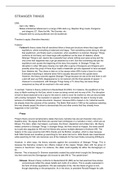STRANGER THINGS
ERA:
- Set in the 1980’s
- Makes intertextual references to a range of 80s texts e.g- Stephen King novels, Dungeons
and dragons, ET, Stand by Me, The Goonies, etc.
- Enjoyed both by young audiences and old audiences
Theories to apply: (Narrative theorists)
Todorov:
- Todorov's theory states that all narratives follow a three-part structure where they begin with
equilibrium, where everything is balanced and happy. Then something comes along to disrupt
that equilibrium, and finally reach a resolution, when equilibrium is restored. Stranger Things
conforms to his theory as it does begin with equilibrium as the town of Hawkins, where
Stranger Things is set, seems like a peaceful town where nothing ever goes wrong and the
only crime that happened was a girl got attacked by a bird. But then something disrupts the
equilibrium and causes the beginning of the story line properly. In Stranger Things, the
disruption is when Will goes missing one night after a game of Dungeons and Dragons and
possibly when the group of three boys meets a telekinetic girl who appeared to have escaped
from Hawkins lab. The climax is later on in the season when Will’s body is found in a lake.
Eventually everything is restored when Will is actually rescued from the upside down.
However, the theory subverts against Stranger Things because we see at the end there is still
a plot left open as Will’s disappearance is not resolved until the final episode of season 1.
However to counterpoint, with Stranger Things being a TV show they can leave things
unresolved as they will be resolved in the next series.
In contrast, Todorov’s theory conforms to Deutschland 83 (D83). For instance, the equilibrium in the
story is Martin working for the East, which is seen as being normal and his way of life. The disruption
is that he faces blackmail to be a spy for the west in order to save his mother so she can be provided
with a kidney transplant. The resolution in episode 1 is that he completes his task in having to take
pictures of confidential, private documents. However, because D83 is based on tru, historical events
we already know the outcome of the narrative. The Berlin Wall ends in 1990 so the audience watching
this may already expect the show to demonstrate this and other events that they already know
happened in the Cold War.
- Propp
Propp's theory around narrative/story states that every narrative has pre-set character roles and a
baseline story. He argues that there are several main archetypes in a narrative or story, which are as
follows; The Hero, villain, the helpers, a princess, the Donor, dispatcher and a false hero. His theory
widely conforms to Stranger Things. In stranger things, the Hero would be Hopper, the towns sheriff
but could also arguably be Will and his friends who pursue multiple attempts to find/save Will. The
helpers in this case would be both Will’s friends and his Brother Jonathan, which is clear because
both Wills friends and Jonathan go searching for him when told not to. Wills friends also meet Eleven
while searching for Will, who becomes one of the Catalysts for the town finally recovering Will Byers.
However, in other ways, the theory subverts against the conventions of Stranger Things. This is
because the Narrative contains two Villains instead of the classic “Single villain with his group of
minions or henchmen” clique. For instance, the villain could arguably be either the demogorgon or
Dr.
Brenner. This is because Dr. Brenner essentially created the portal which brought the Demogorgon
into their world and the Demogorgon did choose to take Will to “The upside-down”.
- Strauss: Straus’s theory conforms to Deutschland 83 (D83) as he had examined how stories
unconsciously reflect the values beliefs and myths of a culture. This is usually expressed in
the form of binary oppositions. We see examples of this, like the theme of good vs evil,
though depending on the perspective. As in the show, to president Ronald Reagan he calls





